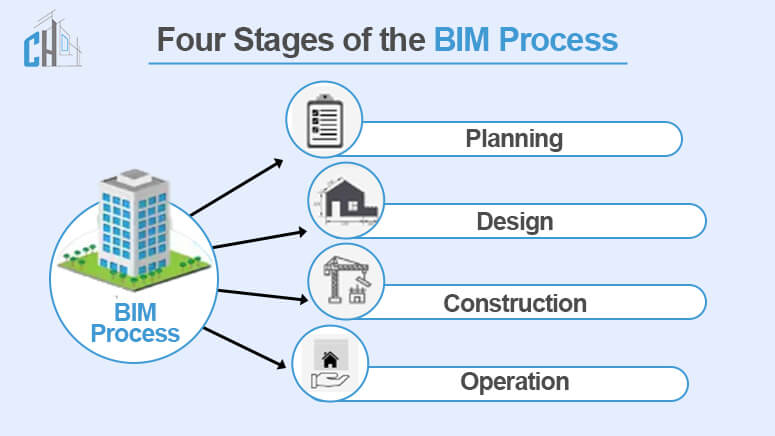Quick summary: Building Information Modeling (BIM) is at the cutting edge of this revolution, although the construction industry has never been shy about innovation. So, what is BIM construction and why is it such a big hype? If you are a construction professionals, project manager and architects throughout the USA, knowing the cost-saving possibilities of the same, saves rocket science in the success of your projects.
In this post we are going to demonstrate how BIM technology is transforming the construction sector and open the way to uncovering savings opportunities. Then, we will highlight BIM and cost reduction, explore best practices for BIM integration and state the future of BIM technology. You will realize by the end, why BIM is not merely a good tool but a necessity for cost-effective construction.
Introduction to BIM
Building Information Modeling (BIM) is a process that is used throughout the world and becomes essential in today’s advancement in construction projects. Put simply, BIM requires digital models that show the physical and functional characteristics of a building. The utilization of these models span the entire life of the building from design, constructing, and even maintenance.
The importance of MEP BIM in construction is growing. In many cases, the way we handle processes today is broken, and different stakeholders working alone on their unique activities will create inefficiencies and expensive mistakes.
In comparison, BIM is a collaborative environment that brings together architects, engineers, contractors, and owners in a unified data environment. The integration not only avoids duplicate work and inefficiency but also provides strong savings.
For those in construction and project management, changing times call for change, and BIM contributes to making the most of potential competitive advantages. Using virtual design and construction BIM, we can predict problems and plan corrections before it becomes an expensive issue.
It is a forward-thinking approach that puts accuracy and efficiency at the forefront, both of which are critical in the fast-paced world of construction today.
The Importance of Building Information Modeling Today
In today’s world, Building Information Modeling (BIM) has evolved from a luxury to a necessity. With the United Nations estimating an increase in the world population to 9.7 billion by 2050, the architecture, engineering, and construction (AEC) sector faces increasing pressure to implement more deliberate and sustainable design.
This change is necessary as the demand for spaces increases and so the construction solutions need to be innovative as well.
As a result, more and more governments need to use building information models for public contracts, and more private clients have realized the value of this approach.
The Role of BIM in Cost Savings
One of the most attractive advantages of using BIM in construction is the potential for high cost savings. BIM is a technology that when used properly maximizes all phases of the construction process, from design until maintenance letting the resources use as much as possible and minimizes the wastage.
First, BIM allows for more precise estimation on projects. Through a comprehensive, three-dimensional representation of a project, BIM gives more accurate figures for quantity take offs and cost calculations. Since this level of detail minimizes the probability of budget overruns and unplanned costs- a problem of traditional construction methodologies-
Secondly, BIM aids collaboration between all the teams involved in the project. When all stakeholders share the same model, communication silos are broken and inconsistencies or conflicts can be detected early in the planning process. Minimizes expensive rework or changes in case construction is underway, thus saving time and money.
Finally BIM helps in effective management of resources. BIM allows project managers to simulate different building situations to gain insights into resource allocation. In other words, labour, materials, and time are used to their fullest capacity to avoid over-ordering or under-utilisation of resources, which could lead to money spent in the wrong way.
How Does the BIM Process Work?

A building information model can be used throughout a project lifecycle to bring clarity and efficiency into a building’s construction:
Planning: With reality capture and real-world data, BIM software can inform, guide, and simplify project planning to give each of its users an understanding of how a building will realistically look in its environment.
Design: Of any part of the construction process, this can arguably be the most complicated, as it usually involves conceptual design, analysis and lots of documentation.
BIM data can deliver the modeling that breaks down the construction and generate valuable metrics on a design’s performance. It can also greatly assist in logistics, streamline scheduling, and make sure that all necessary stakeholders have the right information during this.
Construction: For this phase much of the fabrication can be guided through BIM project specifications and documents sharing.
Operation: By containing information-rich models as well as asset data, BIM can support operations, maintenance, refurbishment, extension, and even demolition.
Future of BIM in Construction
The direction in which construction BIM is headed bodes well for the future, as we are continuously innovating with even more groundbreaking possibilities. The most exciting is the incorporation of technology including artificial intelligence and machine learning into the BIM process.
This carries a potential to increase the predictive analytics even further, that would enable the project manager to foresee any issues in advance, and thereby further optimizing the resource allocation.
Sustainable construction us another domain where bim is growing. BIM models have also incorporated energy analysis and sustainability assessments, helping construction professionals design and build buildings that align with more stringent environmental requirements. It not only minimizes the environmental footprint but also caters to the rising requirement forecast in the construction industry for green building technology.
In addition, the growing adoption of cloud-based BIM will improve collaboration across international teams. Cloud-based bim facilitate real-time access to updated models and data, so seamless communication and decision-making can occur, no matter if there is a distance. This is especially helpful for huge projects with several stakeholders based across different regions.
Conclusion
BIM is more than just a technology; with its features, it is an implementation game-changer, helping save a lot of money on construction projects. In this way, the construction professionals save costs and be better managed on resources during a project by optimizing the process of design through to maintenance and better collaboration among teams.
Utilizing the most out of builders information modeling calls for teamwork integrated within your project. With clear goals, proper training and the right tools, you can take full advantage of what BIM technology offers and ensure your place in the construction market!
Here at our CAD drafting company, you can employ all these strategies without burning a hole in your pocket by leveraging our affordable outsourcing BIM services.
The future of BIM will integrate seamlessly into construction management with the help of AI BIM modeling, sustainability, and cloud-based solutions. If you are a construction professional, project manager, or architect, understanding BIM and how to incorporate it into your projects is no longer optional—it is essential to succeed in the ever-evolving world of construction.




